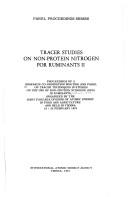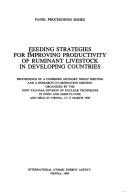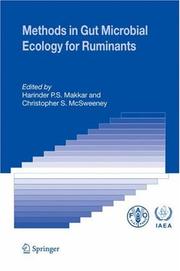| Listing 1 - 10 of 14 | << page >> |
Sort by
|
Periodical
ISSN: 18790941 Year: 1988 Publisher: [Amsterdam ; New York, NY] : Elsevier Science
Abstract | Keywords | Export | Availability | Bookmark
 Loading...
Loading...Choose an application
- Reference Manager
- EndNote
- RefWorks (Direct export to RefWorks)
Ruminants --- Bovidae --- Bovidés --- Oreamnos americanus --- Goats, Mountain --- Ruminantia --- Goat, Mountain --- Mountain Goat --- Mountain Goats --- Ruminant --- Bovids --- Cavicornia --- Ruminant mammals --- Artiodactyla --- Ruminants.
Book
ISBN: 2759228959 2759228967 2759228940 Year: 2019 Publisher: éditions Quae
Abstract | Keywords | Export | Availability | Bookmark
 Loading...
Loading...Choose an application
- Reference Manager
- EndNote
- RefWorks (Direct export to RefWorks)
De 1974 à 2014, l’Afrique intertropicale a connu une croissance inédite des effectifs des herbivores domestiques. Les effectifs bovins ont été multipliés par plus de 2, ceux des petits ruminants par plus de 3. Aujourd’hui, la région regroupe environ 20 % des bovins et des ovins, 33 % des caprins et 81 % des dromadaires élevés sur la planète. Soit un cheptel de près de 900 millions de têtes. L’ouvrage est axé sur la dynamique des élevages des ruminants et des équidés en Afrique intertropicale. Il décrit les différents systèmes d’élevage rencontrés en zones aride et subhumide et les ressources alimentaires disponibles ; il aborde les impacts locaux et globaux des élevages des herbivores sur l’environnement. Le rôle socio-économique majeur des activités autour des animaux et de leurs produits, et la demande croissante en viande et lait des consommateurs sont soulignés. Une organisation efficace des filières bétail-viande est rapportée, alors que des contraintes à la mise en place d’une industrie laitière persistent. Pour de nombreuses familles vivant proches du seuil de pauvreté, l’élevage est un facteur de réduction de la vulnérabilité. Divers services qui permettraient un développement durable des élevages sont décrits. Cependant, les modes de financements et les suivis des impacts socio-économiques et environnementaux devront évoluer.
Tropical agriculture: practice & techniques --- sustainable development --- Africa --- rural development --- animal production --- dairy products --- animal husbandry --- water resources --- environment --- food security --- cattle --- goats --- farming --- sheep --- technical advice --- fodder --- animal pathology --- pasture --- poultry --- zootechnics --- ruminant

ISBN: 9201111754 Year: 1975 Publisher: Vienna International atomic energy agency
Abstract | Keywords | Export | Availability | Bookmark
 Loading...
Loading...Choose an application
- Reference Manager
- EndNote
- RefWorks (Direct export to RefWorks)
636.085.1 --- Proteins --- -Radioactive tracers in animal nutrition --- -Ruminants --- -#IHE:BWET --- Ruminant mammals --- Ruminantia --- Artiodactyla --- Animal nutrition --- Proteids --- Biomolecules --- Polypeptides --- Proteomics --- 636.085.1 Composition of feedstuffs --- Composition of feedstuffs --- Synthesis --- -Congresses --- Congresses --- Feeding and feeds --- Nitrogen in animal nutrition --- Radioactive tracers in animal nutrition --- -Proteins --- -Ruminant mammals --- Ruminants --- #IHE:BWET --- Synthesis&delete& --- Feeding and feeds&delete& --- Congresses. --- Protéines --- Synthèse --- Congrès --- Report

ISSN: 00741876 ISBN: 9201111894 Year: 1989 Volume: vol *67 Publisher: Vienna : International Atomic Energy Agency,
Abstract | Keywords | Export | Availability | Bookmark
 Loading...
Loading...Choose an application
- Reference Manager
- EndNote
- RefWorks (Direct export to RefWorks)
Livestock --- Bétail --- Feeding and feeds --- Alimentation et aliments --- FAO --- IAEA --- Alimentation des animaux --- Animal feeding --- Pays en développement --- Developing countries --- Conduite d'élevage --- Livestock management --- Bovin --- Cattle --- Aliment pour animaux --- feeds --- Possibilité de production --- production possibilities --- Ruminant --- ruminants --- Austria --- -Ruminants --- -Feeds --- -Livestock productivity --- -Ruminant mammals --- Ruminantia --- Artiodactyla --- Productivity, Livestock --- Agricultural productivity --- Animal feeds --- Animal rations --- Animals --- Domestic animals --- Feed --- Feeding and feeding stuffs --- Feeding stuffs --- Feedingstuff --- Feedstuff --- Fodder --- Livestock rations --- Rations, Animal --- Rations, Livestock --- Farm supplies --- Fodder banks --- Feeding --- Feeding, Animal --- Feeding of animals --- Feeds --- Congresses --- -Congresses --- Developing --- Livestock productivity --- Ruminants --- Bétail --- Report --- Feeding strategy
Book
Year: 2021 Publisher: Basel, Switzerland MDPI - Multidisciplinary Digital Publishing Institute
Abstract | Keywords | Export | Availability | Bookmark
 Loading...
Loading...Choose an application
- Reference Manager
- EndNote
- RefWorks (Direct export to RefWorks)
Numerous pathogens affect animal health and wellbeing and production efficiency. These pathogens also have a considerable impact on social economics, food safety and security, and human health. Infectious diseases that originate from both domesticated animals and wildlife represent one of the greatest threats to human health. Recent studies show that domesticated species harbor approximately 84 times more zoonotic viruses than wild species. Eight of the top 10 mammalian species with the highest number of zoonotic viruses are domestic, such as pigs, cattle, and horses. Many animal parasites are also zoonotic, constituting an additional burden on human health. Furthermore, the rapid emergence and spread of drug-resistant pathogen strains pose new threats to animal and human health. Climate changes will undoubtedly alter the interactions between animals and between animals and humans, which will have a huge impact on the transmission rate of existing pathogens and the emergence of new pathogens or the reemergence of old pathogens. In this special collection, interactions of all major pathogen types, including viruses, bacteria, mites and flies, protozoans, and helminths, and their hosts, such as wild and companion animals and livestock species, are discussed. Further, anthelmintic activities of natural products are evaluated. The relevance and utility of cutting-edge tools, such as immunology, genomics and genetics, microbiome studies and metabolomics, and molecular epidemiology, in dissecting host-pathogen interactions are also discussed. This special collection provides a broad knowledge base that encourages dialogue across a wide distribution of the research community in veterinary microbiology and parasitology.
Medicine --- dietary treatments --- plant bioactive compounds --- egg counts --- UHRMS --- Haemonchus contortus --- Crotalus ravus --- Crotalus triseriatus --- venom --- antibacterial activity --- Pseudomonas aeruginosa --- hemolytic activity --- maedi-visna virus --- ovine progressive pneumonia --- small ruminant lentivirus --- dairy sheep --- horse --- colic --- gastrointestinal disease --- Strongylus vulgaris --- Anoplocephala perfoliata --- cyathostominae --- D. gallinae --- hematophagous ectoparasite --- poultry red mite --- antibody titre --- lymphocyte subpopulation --- Sarcocystis spp. --- COX1 --- Camelus dromedarius --- post-mortem microbiology --- veterinary forensic pathology --- sudden death --- young dogs --- bovine digital dermatitis --- cattle lameness --- microbiome --- Treponema spp --- Ancylostoma ceylanicum --- community dogs --- ITS region --- cox1 --- Thailand --- population diversity --- Sarcoptes scabiei --- host-parasite interaction --- molecular characterization --- lipid profile --- antioxidant --- rodent --- helminth --- cestode --- trematode --- nematode --- Middle East --- meta-analysis --- Brugia pahangi --- Dirofilaria immitis --- PCR-RFLP --- spatial distribution --- altitude --- myiasis --- prevalence --- Oestrus ovis --- mtCOI --- sheep --- goats --- Saudi Arabia --- anoplocephala perfoliata --- equine --- gut microbiome --- volatile organic compounds (VOCs) --- omics integration --- tick-borne fever --- Anaplasma phagocytophilum-like 1 --- small ruminant

ISBN: 1280461381 9786610461387 1402037910 1402037902 9048169666 Year: 2005 Publisher: Dordrecht : Springer Netherlands : Imprint: Springer,
Abstract | Keywords | Export | Availability | Bookmark
 Loading...
Loading...Choose an application
- Reference Manager
- EndNote
- RefWorks (Direct export to RefWorks)
Asaresultofvarioushumanactivities,suchasincreaseinhumanpopulation,decrease in arable land due to soil degradation, urbanization, industrialization and associated increase in the demand for livestock products, dramatic changes are occurring in the global ruminant livestock sector. These changes includeshift inthesize of regional livestock populations and in the types of management and feeding systems under which ruminant livestock are held, and increased demand of a wider range of quality attributes from animal agriculture, not just of the products themselves but also of the methods used in their production. The livestock sector will need to respond to newchallengesofincreasinglivestockproductivitywhileprotectingenvironmentand human health and conservingbiodiversity and natural resources. The micro-organisms in the digestive tracts of ruminant livestock have a profound in?uence on the conversion offeedinto end products, which can impact on the- imal and theenvironment. As the livestock sector grows particularly in developing countries, there will be an increasing need to understand these processes for b- ter management and use ofbothfeed and other natural resources that underpinthe development of sustainable feeding systems.
Rumen --- Ruminants --- Microbiology. --- Digestive organs. --- Ruminant mammals --- Ruminantia --- Artiodactyla --- Bacteriology --- Zoology. --- Agriculture. --- Ecology. --- Microbial ecology. --- Molecular ecology. --- Microbial Ecology. --- Molecular Ecology. --- Microbial biology --- Biology --- Microorganisms --- Ecology --- Molecular biology --- Environmental microbiology --- Microbiology --- Balance of nature --- Bionomics --- Ecological processes --- Ecological science --- Ecological sciences --- Environment --- Environmental biology --- Oecology --- Environmental sciences --- Population biology --- Farming --- Husbandry --- Industrial arts --- Life sciences --- Food supply --- Land use, Rural --- Natural history --- Animals --- Molecular aspects --- Ecology .
Book
ISBN: 9788132224013 8132224000 9788132224006 8132224019 Year: 2015 Publisher: New Delhi : Springer India : Imprint: Springer,
Abstract | Keywords | Export | Availability | Bookmark
 Loading...
Loading...Choose an application
- Reference Manager
- EndNote
- RefWorks (Direct export to RefWorks)
This book offers an in-depth description of different groups of microbes (i.e. bacteria, protozoa, fungi and viruses) that exist in the rumen microbial community, and offers an overview of rumen microbiology, the rumen microbial ecosystem of domesticated ruminants, and rumen microbial diversity. It provides the latest concepts on rumen microbiology for scholars, researchers and teachers of animal and veterinary sciences. With this goal in mind, throughout the text we focus on specific areas related to the biology and complex interactions of the microbes in rumen, integrating significant key issues in each respective area. We also discuss rumen manipulation with plant secondary metabolites, microbial feed additives, utilization of organic acids, selective inhibition of harmful rumen microbes, and ‘omics’ approaches to manipulating rumen microbial functions. A section on the exploration and exploitation of rumen microbes addresses topics including the current state of knowledge on rumen metagenomics, rumen: an underutilized niche for industrially important enzymes, and ruminal fermentations to produce fuels. We next turn our attention to commercial applications of rumen microbial enzymes and to the molecular characterization of euryarcheal communities within an anaerobic digester. A section on intestinal disorders and rumen microbes covers acidosis in cattle, urea/ ammonia metabolism in the rumen, and nitrate/ nitrite toxicity in ruminant diets. Last, the future prospects of rumen microbiology are examined, based on the latest developments in this area. In summary, the book offers a highly systematic collection of essential content on rumen microbiology.
Life Sciences. --- Microbial Ecology. --- Bacteriology. --- Biodiversity. --- Eukaryotic Microbiology. --- Microbial Genetics and Genomics. --- Life sciences. --- Microbial ecology. --- Microbiology. --- Microbial genetics. --- Sciences de la vie --- Biodiversité --- Ecologie microbienne --- Bactériologie --- Microbiologie --- Génétique microbienne --- Rumen -- Microbiology. --- Ruminants. --- Biology --- Health & Biological Sciences --- Microbiology & Immunology --- Rumen --- Ruminant mammals --- Ruminantia --- Bacteriology --- Microbial genomics. --- Artiodactyla --- Genomics --- Microbial genetics --- Microorganisms --- Genetics --- Microbiology --- Microbial biology --- Biological diversification --- Biological diversity --- Biotic diversity --- Diversification, Biological --- Diversity, Biological --- Biocomplexity --- Ecological heterogeneity --- Numbers of species --- Environmental microbiology --- Ecology
Book
ISBN: 331930531X 3319305336 Year: 2016 Publisher: Cham : Springer International Publishing : Imprint: Springer,
Abstract | Keywords | Export | Availability | Bookmark
 Loading...
Loading...Choose an application
- Reference Manager
- EndNote
- RefWorks (Direct export to RefWorks)
The book combines information about the behaviour that allowed ruminants to survive and to evolve on Earth: the rumen. Furthermore, the reader will find aspects involving rumen anatomy, physiology, microbiology, fermentation, metabolism, manipulation, kinetics and modeling. Thus, the book was not only organized to help students involved in areas such as ruminant nutrition and ruminant production but collegians gathering material for teaching practices. .
Life sciences. --- Animal anatomy. --- Animal genetics. --- Animal physiology. --- Life Sciences. --- Animal Physiology. --- Animal Anatomy / Morphology / Histology. --- Animal Genetics and Genomics. --- Animal Systematics/Taxonomy/Biogeography. --- Rumen --- Ruminants --- Microbiology. --- Nutrition. --- Ruminant mammals --- Ruminantia --- Bacteriology --- Artiodactyla --- Morphology (Animals). --- Genetics --- Animal morphology --- Animals --- Body form in animals --- Zoology --- Morphology --- Animal physiology --- Biology --- Anatomy --- Physiology --- Animal systematics. --- Animal taxonomy. --- Animal classification --- Animal systematics --- Animal taxonomy --- Classification --- Systematic zoology --- Systematics (Zoology) --- Taxonomy, Animal --- Zoological classification --- Zoological systematics --- Zoological taxonomy --- Animal anatomy
Book
ISBN: 1556641362 9781556641367 Year: 1991 Publisher: London ; New York, NY ; Rheine : BC Decker,
Abstract | Keywords | Export | Availability | Bookmark
 Loading...
Loading...Choose an application
- Reference Manager
- EndNote
- RefWorks (Direct export to RefWorks)
Veterinary physiology --- Animal --- Veterinary physiology. --- Physiology --- Physiologie vétérinaire --- Physiologie --- physiology. --- Animals --- physiology --- Physiologie animale --- Animal physiology --- Santé animale --- Animal health --- Métabolisme --- Metabolism --- Système nerveux --- Nervous system --- Appareil digestif --- Digestive system --- Système cardiovasculaire --- Cardiovascular system --- Ruminant --- ruminants --- Petits ruminants --- small ruminants --- Animal monogastrique --- monogastric animals --- Animals. --- Physiology. --- 591.1 --- 636 --- Biology --- Anatomy --- Animalia --- Metazoa --- Animal husbandry and breeding in general. Livestock rearing. Breeding of domestic animals --- 636 Animal husbandry and breeding in general. Livestock rearing. Breeding of domestic animals --- 591.1 Animal physiology --- Physiologie vétérinaire --- Domestic animals --- Livestock --- Animals - physiology
Book
Year: 2020 Publisher: Basel, Switzerland MDPI - Multidisciplinary Digital Publishing Institute
Abstract | Keywords | Export | Availability | Bookmark
 Loading...
Loading...Choose an application
- Reference Manager
- EndNote
- RefWorks (Direct export to RefWorks)
Ruminants contribute significantly to human food security. However, the production of ruminants contributes to greenhouse gas (GHG) emissions that are responsible for climate change. GHGs such as methane, carbon dioxide, and nitrous oxide are produced from different processes of ruminant production. Ruminant enteric methane is a substantial component of methane produced by agriculture. This book presents novel and established methods in quantifying and reducing enteric methane emission from ruminants in different production systems. The book covers different types of ruminants including cattle, sheep, and goats. The chapters are contributed by scientists and authors from different parts of the world, demonstrating the importance of this problem and the universal drive for immediate and sustainable solutions. Although, biologically speaking, the production of enteric methane cannot be reduced to zero, high emissions are an indicator of inefficient digestion of feed in the rumen and low utilisation of feed energy. By presenting research that could lead to robust and yet practical quantification methods and mitigation strategies, this book not only contributes to the discourse and new knowledge on the magnitude of the problem but also brings forward potential solutions in different livestock production systems.
Research & information: general --- Biology, life sciences --- Technology, engineering, agriculture --- environmental modelling --- pasture systems --- nitrous oxide --- methane emissions --- nitrate leaching --- climate change --- heat stress --- goat --- immunization --- methane --- volatile fatty acids --- backgrounded cattle --- encapsulated nitrate --- essential oil --- nitrogen balance --- reduction strategy --- rumen fermentation --- microbial flora --- tea saponins --- Moringa oleifera --- fecal methanogenic community --- dairy cows --- mcrA gene sequencing technique --- methane emission --- tropical beef cattle --- Desmanthus --- supplementation --- growth performance --- ruminant nutrition --- legumes --- NDIR --- laser --- agreement --- enteric emissions --- interchangeability --- heifer --- forage-to-concentrate ratio --- prediction equation --- sulphur hexafluoride tracer technique --- genetic evaluation --- greenhouse gases --- environment --- dairy goat farming --- linear programming --- GHG emissions --- abatement cost --- mitigation options --- carbon footprint
| Listing 1 - 10 of 14 | << page >> |
Sort by
|

 Search
Search Feedback
Feedback About
About Help
Help News
News